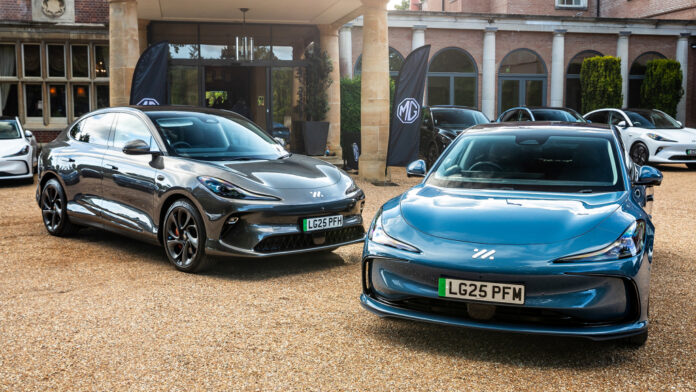“Chinese Volkswagen has achieved remarkable success, outpacing all other newcomers in the automotive market.” This statement reflects a significant trend in the automotive industry, where established brands are increasingly challenged by emerging players. As the market evolves, a new contender is stepping up to the plate: MG. With its IM models targeting the upper class, MG aims to disrupt the status quo and redefine expectations. But what does this mean for consumers and competitors alike?
The stakes are high as MG enters a segment traditionally dominated by established luxury brands. With competitive pricing and a focus on innovative technology, MG is not merely joining the fray; it is actively seeking to reshape consumer perceptions and market dynamics. As the automotive landscape transforms, the question arises: can MG leverage its unique positioning to carve out a substantial niche in the luxury segment? This article explores the implications of MG’s ambitious strategy and the potential impact on the automotive market.
Mg’s Bold Entry Into the Luxury Segment
MG’s foray into the luxury automotive market is a calculated move that reflects a broader trend of diversification among automotive manufacturers. Historically known for its affordable vehicles, MG is now positioning itself as a serious competitor in the upper-class segment, a space traditionally occupied by established luxury brands such as BMW and Mercedes-Benz. The introduction of the IM models marks a significant shift in MG’s branding strategy, aiming to attract a more affluent customer base while maintaining competitive pricing.
With the IM models, MG is not just offering vehicles; it is providing a lifestyle choice that appeals to consumers looking for luxury without exorbitant costs. The pricing strategy is particularly noteworthy, as MG aims to deliver features typically associated with high-end vehicles at a fraction of the cost. This approach could potentially disrupt the market, enticing consumers who may have previously considered only established luxury brands. As MG continues to evolve, its ability to balance affordability with luxury will be crucial in determining its success.
The implications of MG’s entry into the luxury market extend beyond just pricing. The company is also focusing on innovative technology and sustainability, which are increasingly important to today’s consumers. By integrating advanced features such as electric powertrains and smart technology, MG is positioning itself as a forward-thinking brand that resonates with environmentally conscious buyers. This strategy not only enhances the appeal of the IM models but also aligns with global trends toward sustainability in the automotive sector.
The Competitive Landscape: Mg Vs. Established Brands
As MG enters the luxury segment, it faces formidable competition from established automotive brands that have spent decades building their reputations. Companies like Audi, Lexus, and Jaguar have a loyal customer base and a well-established presence in the market. However, MG’s unique approach may provide it with a distinct advantage. By offering high-quality vehicles at competitive prices, MG could attract consumers who are seeking value without sacrificing luxury.
Moreover, MG’s marketing strategy emphasizes its heritage and commitment to innovation, which may resonate with a new generation of buyers. The brand’s focus on connectivity, performance, and design is intended to appeal to tech-savvy consumers who prioritize features that enhance their driving experience. This focus on modernity and value could disrupt traditional loyalty patterns, encouraging consumers to explore alternatives to their usual choices.
The challenge for MG will be to maintain quality and performance standards while scaling production to meet increasing demand. As the brand gains traction, it must ensure that its manufacturing processes can uphold the promises made in its marketing campaigns. Failure to deliver on these expectations could undermine consumer trust and hinder MG’s ability to compete effectively in the luxury segment.
Consumer Perceptions and Market Trends
The automotive market is undergoing a significant transformation, influenced by changing consumer preferences and technological advancements. Today’s buyers are more informed and discerning, often prioritizing sustainability, connectivity, and overall value. MG’s entry into the luxury market comes at a time when consumers are increasingly seeking alternatives to traditional luxury brands, opening the door for newcomers to make their mark.
Consumer perceptions of MG are evolving as the brand invests in high-quality materials and cutting-edge technology. By emphasizing its commitment to innovation and customer satisfaction, MG aims to redefine what luxury means in the automotive context. This shift may encourage potential buyers to reconsider their preconceived notions about the brand, allowing MG to capture a share of the luxury market that it previously could not access.
Additionally, market trends indicate a growing demand for electric and hybrid vehicles, further aligning with MG’s strategic direction. As more consumers prioritize eco-friendly options, MG’s focus on sustainable practices and electric powertrains could position it favorably in the eyes of environmentally conscious buyers. This alignment with consumer values is crucial for MG’s long-term success in a competitive landscape.
The Future of Mg in the Automotive Industry
Looking ahead, MG’s ambitions in the luxury automotive market will depend on its ability to innovate and adapt to changing consumer needs. The brand’s commitment to quality, technology, and sustainability will be pivotal in establishing its reputation among luxury consumers. As MG continues to roll out its IM models and expand its offerings, the automotive industry will closely watch its progress and impact.
Furthermore, MG’s success could encourage other emerging brands to explore similar strategies, potentially reshaping the competitive landscape of the automotive market. As new players enter the field, established brands may need to reassess their approaches to maintain their market positions. This shift could lead to increased innovation and better options for consumers across all segments of the automotive industry.
Ultimately, MG’s journey in the luxury segment is just beginning, and its ability to navigate the challenges ahead will determine its place in the market. By focusing on what sets it apart and delivering on its promises, MG has the potential to become a significant player in the luxury automotive space, altering consumer perceptions and expectations along the way.


